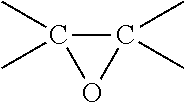Radiation curable resin composition and rapid three dimensional imaging process using the same
a three-dimensional imaging and composition technology, applied in the field of radiation curable compositions, can solve the problems of low toughness/impact resistance of articles, excessive color development, and part distortion, and achieve the effects of high toughness, high impact strength, and high (tensile) modulus
- Summary
- Abstract
- Description
- Claims
- Application Information
AI Technical Summary
Benefits of technology
Problems solved by technology
Method used
Image
Examples
examples
[0139]
TABLE 1Materials ListMaterial NameMaterial DescriptionVendorEpon 825Bisphenol A Diglycidyl Ether EpoxyResolution PerformanceResinProductsCyracure UVR-61053,4-Epoxy Cyclohexyl Methyl-3,4-EpoxyDow ChemicalCyclohexyl CarboxylateEbecryl 3605Partially acrylated Bisphenol-A epoxyUCB / CytecresinOxetane OXT-1013-ethyl-3-hydroxymethyl-oxetaneToagoseiVinylether ethyl2-(2-Vinyloxyethoxy)ethyl acrylateNippon Shokubai Co. Ltd.acrylateEbecryl 3700Bisphenol-A epoxy diacrylateUCB / CytecSR-399Dipentaerythritol Pentaacrylate EstersSartomerSR 349Bisphenol A Ethoxylate DiacrylateSartomerSynFac 8025UPolyalkoxylated Bisphenol AMilliken ChemicalSynFac 8009Polyalkoxylated Bisphenol AMilliken ChemicalStepanpol PS2002Di[(diethylene glycol) o-phthalate]Stepan CompanyEmulgen BPA-5Polyalkoxylated Bisphenol AKao Specialties AmericasBisphenol APolyalkoxylated Bisphenol AAldrich(ethoxylate)4,Average Mn = 404 g / molEO(4)BPATriethylene GlycolAldrichPluracol TP 440Propoxylated TrimethylolpropaneBASFTerathane 1000P...
examples 1-3
[0142]Post cure was performed by storing the samples for approximately 20 h at 80° C. in a hot air oven. After post cure the samples were stored for at least a week at room temperature (23° C.) and 50% relative humidity before the testing was performed. K1c and tensile testing of these samples was performed under the same environmental conditions.
Preparation of Hybrid Formulations
examples 4-10
, Comparative Experiments A-D
Preparation of Dispersions (Table 4 and Table 5a, 5b and 5c)
[0143]Core-shell powders were added to epoxy resin with gentle stirring and mixed until the powders were wetted. The slurry was transferred to the mix can of a three-shaft Versamixer manufactured by Charles Ross & Sons. The slurry was mixed at 60 rpm with the anchor mixer, while the water jacket was heated with hot water. When the slurry temperature reached 35° C., the disperser speed was set to 5000 rpm and the water flow to the water jacket was stopped. When the slurry temperature rose to 45° C., the disperser speed was raised to 6500 rpm and the emulsifier speed was set at 5500 rpm. The mix can was evacuated to a vacuum of 948 mbar once the temperature reached 60° C. When the temperature reached 80-82° C., the disperser and emulsifier were turned off and the mixture was cooled by flowing cold water through the water-jacket. Once the temperature fell below 50° C., the anchor agitator was turne...
PUM
| Property | Measurement | Unit |
|---|---|---|
| storage modulus | aaaaa | aaaaa |
| storage modulus | aaaaa | aaaaa |
| power | aaaaa | aaaaa |
Abstract
Description
Claims
Application Information
 Login to View More
Login to View More - R&D
- Intellectual Property
- Life Sciences
- Materials
- Tech Scout
- Unparalleled Data Quality
- Higher Quality Content
- 60% Fewer Hallucinations
Browse by: Latest US Patents, China's latest patents, Technical Efficacy Thesaurus, Application Domain, Technology Topic, Popular Technical Reports.
© 2025 PatSnap. All rights reserved.Legal|Privacy policy|Modern Slavery Act Transparency Statement|Sitemap|About US| Contact US: help@patsnap.com



